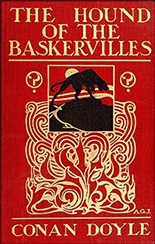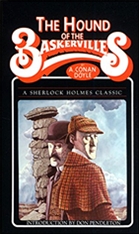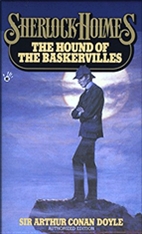Wed 22 Nov 2023
A 1001 Midnights Review: ARTHUR CONAN DOYLE – The Hound of the Baskervilles.
Posted by Steve under 1001 Midnights , Reviews[2] Comments
by Edward D. Hoch

ARTHUR CONAN DOYLE – The Hound of the Baskervilles. George Newnes Ltd., UK. hardcover, March 1902. McClure Philips & Co, US, hardcover, 1902. Originally serialized in The Strand Magazine from August 1901 to April 1902. Reprinted numerous times. Adapted to radio, TV and the movies even more countless times.
Unlike the first two Sherlock Holmes novels, The Hound of the Baskervilles is successful in every way, a book that would be a classic even without the buttressing of the Holmes short stories. The legend of a gigantic hound that stalks the members of the Baskerville family on the moor near their ancestral home forms the background for the only Holmes novel to tell a complete story without recourse to a lengthy flashback following the solution.
The book opens with Holmes’s deductions about Dr. James Mortimer, drawn from a walking stick he had left the night before. Mortimer himself soon returns, and tells Holmes and Watson of the legend concerning the Baskerville family. Sir Charles Baskerville has been killed recently, apparently by the gigantic hound of the legend.

Holmes and Watson begin their investigation, with Holmes disappearing for a time to live in disguise on the moor itself. An escaped convict named Selden is in the area, as are a band of Gypsies. Sir Henry Baskerville seems destined to be the next victim, but the convict is killed instead, apparently by mistake. In the end Holmes and Watson face the hound themselves, and find a logical solution to the baffling case.
The Hound of the Baskervilles represents one of the few occasions in the Holmes canon when Doyle uses seemingly supernatural events to heighten the atmosphere of mystery. It is also more of a whodunit than most Holmes stories, with the sort of shifting suspicion that readers came to expect from later writers.

The book can be criticized (and has been. by John Fowles and others) for its marked shortage of pure detection. But it has its clues and its red herrings-and best of all, it has Holmes and Watson, in a story that shows Doyle at the peak of his powers. Neither he nor Holmes would ever be quite so good afterward.
———
Reprinted with permission from 1001 Midnights, edited by Bill Pronzini & Marcia Muller and published by The Battered Silicon Dispatch Box, 2007. Copyright © 1986, 2007 by the Pronzini-Muller Family Trust.
November 23rd, 2023 at 1:17 am
The only one of the novels that is wholly successful and a splendid example of Doyle at his best, even keeping Holmes off stage for the center section of the book works.
Whatever its minor flaws, its major successes more than overcome them. Few books are perfect, but HOUND comes about as close as it can.
November 24th, 2023 at 11:45 pm
Far and away my favorite Sherlock Holmes story of any length and one of my favorite novels, period.